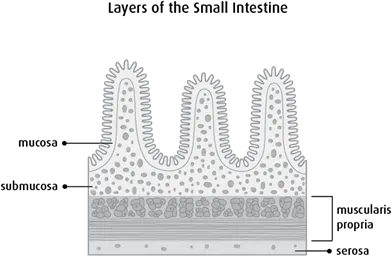Stages of small intestine cancer
Staging describes or classifies a cancer based on how much cancer there is in the body and where it is when first diagnosed. This is often called the extent of cancer. Information from tests is used to find out the size of the tumour, which parts of the small intestine have cancer, whether the cancer has spread from where it first started and where the cancer has spread. Your healthcare team uses the stage to plan treatment and estimate the outcome (your prognosis).
The most common staging system for small intestine cancer is the TNM system. For small intestine cancer there are 5 stages – stage 0 followed by stages 1 to 4. Often the stages 1 to 4 are written as the Roman numerals I, II, III and IV. Generally, the higher the stage number, the more the cancer has spread. Talk to your doctor if you have questions about staging.
When describing the stage, doctors may use the words local, regional or distant. Local means that the cancer is only in the small intestine and has not spread to other parts of the body. Regional means areas close to the small intestine or around it. Distant means in a part of the body farther from the small intestine.
Find out more about staging cancer.
The small intestine is made up of different layers of tissues. The stage often depends on which layer the tumour has grown into.

Stage 0 (carcinoma in situ)
There are cancer cells only in the top part (
Stage 1
The tumour has grown into one of the following areas:
- the layer of connective tissue in the mucosa
- the layer of muscle in the mucosa
- the submucosa
- the muscularis propria
Stage 2A
The tumour has grown into one of the following areas:
- the layer of tissue between the muscularis propria and serosa (subserosa)
- part of the membrane that supports the small intestine (mesentery)
- part of the back of the abdomen (
retroperitoneum )
Stage 2B
The tumour has grown into any of the following areas:
- through the lining that covers and supports the abdominal organs (visceral peritoneum)
- organs near the tumour, such as other loops of the small intestine or the pancreas
- through the serosa to the back of the abdomen and abdominal wall
Stage 3A
The cancer has spread to 1 or 2 lymph nodes near the small intestine.
Stage 3B
The cancer has spread to 3 or more lymph nodes near the small intestine.
Stage 4
The cancer has spread to other parts of the body (called distant metastasis), such as to the liver, lungs or bone. This is also called metastatic small intestine cancer.
Recurrent small intestine cancer
Recurrent small intestine cancer means that the cancer has come back after it has been treated. If it comes back in the same place that the cancer first started, it’s called local recurrence. If it comes back in tissues or lymph nodes close to where it first started, it’s called regional recurrence. It can also recur in another part of the body. This is called distant metastasis or distant recurrence.
